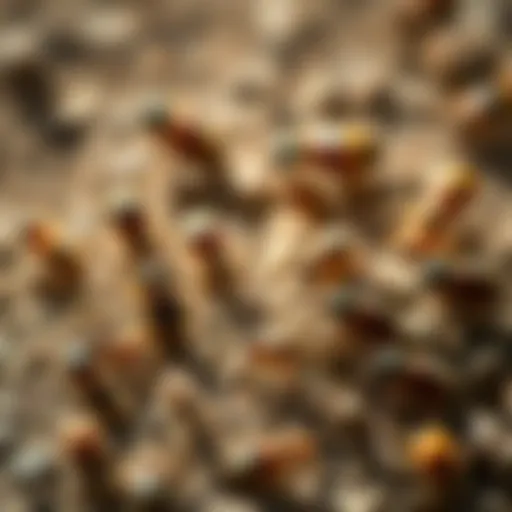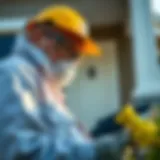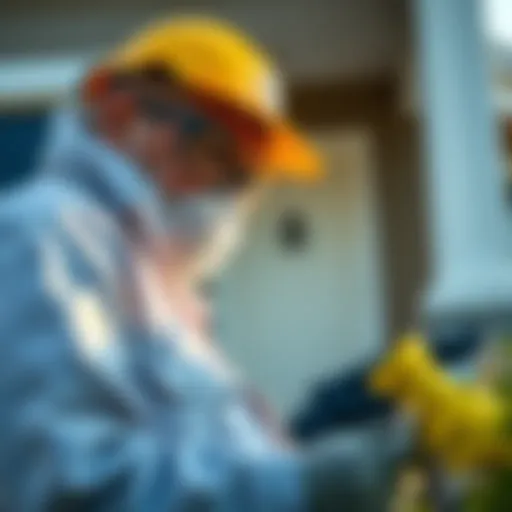Effectively Using Borax for Termite Control Solutions
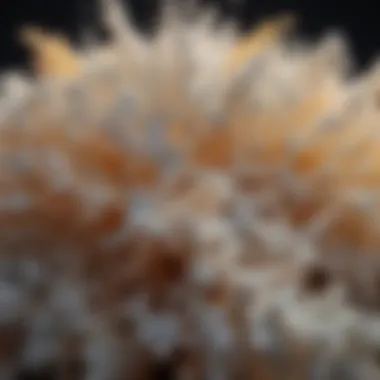

Intro
Termites is a vexing problem for many homeowners. Understanding how to minimize their damage is of utmost importance. This article discusses the use of borax as a potential solution for managing termite infestations. Its properties, effectiveness, and methods of application are explored.
Pest Identification
Common Household Pests
In the realm of household nuisances, termites stand out due to their ability to cause significant damage. There are a few common species generally found in homes:
- Subterranean Termites: These are the most destructive type, creating their nests underground.
- Drywood Termites: They prefer dry wood and live within the wood itself, requiring no soil contact.
- Dampwood Termites: Often found in decaying wood, they thrive in moist environments.
Signs of Infestation
Identifying a termite infestation early can save a great deal of trouble later. Look for:
- Mud tubes ascending walls or other surfaces
- Hollow sounding wood when tapped
- Frass, or termite droppings, resembling tiny wood pellets
"Early detection is the key to an effective termite management strategy."
Prevention Methods
Environmental Modifications
Creating an environment that deters termites is the first line of defense. This includes:
- Keeping wood piles away from the house.
- Ensuring proper drainage around the foundation.
- Reducing moisture in crawl spaces and basements.
Home Maintenance Tips
Regular maintenance helps minimize risks. Important tips include:
- Inspecting your home for any signs of damage.
- Sealing any cracks or crevices in walls or foundations.
- Painting wooden surfaces with preservatives to make them less appealing to termites.
DIY Pest Control Solutions
Natural Remedies
Borax is a natural mineral, often used in pest management for its efficacy. Mixing borax with sugar can attract termites while causing disruption to their digestive systems. Other natural remedies:
- Diatomaceous Earth: A natural powder that can dehydrate insects, including termites.
- Essential Oils: Some like orange oil or neem oil can repel termites.
DIY Traps and Barriers
Setting traps can be an effective DIY method. Use a simple trap such as:
- Boric Acid Bait: Combine sugar, water, and boric acid, and place in areas frequented by termites.
- Moist Cardboard Traps: Soak cardboard and place it where termites frequent. Once infested, remove and destroy the cardboard.
Preamble to Termites and Pest Management
Managing termite infestations is crucial for maintaining the integrity of structures and protecting property investments. Termites are often referred to as silent destroyers. This behavior can lead to significant damage before signs become visible. Therefore, understanding their nature and developing effective pest management strategies is essential.
In the realm of pest control, various methods exist, but innovative, eco-friendly options, like borax, are gaining traction. These alternatives not only control infestations but also align with sustainable practices. This article emphasizes the integration of borax in pest management strategies, making it relevant for homeowners and pest control professionals alike.
Understanding Termite Behavior
Termites play an essential role in the ecosystem, but their dietary habits often bring them into conflict with humans. They primarily consume cellulose, found in wood, paper, and other plant materials. There are several types of termites, including subterranean, drywood, and dampwood. Each type prefers different environments and materials, leading to distinct management considerations.
To effectively combat termites, it is vital to comprehend their activity patterns.
- Colonies: Termite colonies can house thousands of individuals, often comprising workers, soldiers, and reproductive members.
- Foraging Habits: Most subterranean termites forage for food within the soil, often traveling considerable distances to locate food resources.
- Life Cycle: Understanding the life cycle of termites can help homeowners time their interventions more effectively. Recognizing the presence of winged reproductive termites can signal a colony's growth and the need for immediate action.
With insight into these behaviors, effective strategies can be developed to mitigate the risk of infestations.
Importance of Effective Pest Management
The ramifications of termite damage can be severe, leading to costly repairs and reduced property value. Thus, pest management must be proactive rather than reactive.
- Preventive Measures: Regular inspections and timely treatments can help prevent infestations from taking hold. Incorporating borax into these strategies offers a holistic approach to pest control.
- Financial Implications: Investing in effective pest management can save homeowners substantial amounts in the long term by avoiding extensive damage and repair costs.
- Ecosystem Considerations: Effective management also factors in the broader ecological impact. Borax, as a less toxic alternative, is more favorable compared to more traditional chemical termiticides that might contribute to environmental degradation.
In summary, understanding termites’ behavior and implementing solid pest management practices are indispensable steps in preserving property and minimizing potential damage.
Chemical Properties of Borax


The significance of understanding the chemical properties of borax lies in its role as an effective agent in the management of termite infestations. Borax, or sodium borate, is a naturally occurring compound that is utilized not only in household cleaning products but also in various pest control applications. Its effectiveness against termites can be traced back to its unique chemical composition and how it interacts with insect physiology. By comprehending these properties, homeowners can make informed decisions regarding pest control methods.
Composition of Borax
Borax is composed primarily of sodium, boron, oxygen, and water. The chemical formula is Na2B4O7·10O. This means that throughout its structure, there are two sodium ions, four boron atoms, seven oxygen atoms, and a significant amount of water. This composition is what makes borax effective in pest management. The presence of boron is particularly important, as it is essential for many biological processes. In insects, boron disrupts their normal behaviors and biological functions, ultimately leading to their demise.
Toxicity Mechanism Against Insects
The mode of action of borax against termites and other insects revolves around its ability to interfere with the insects' digestive and metabolic processes. When termites ingest borax, it disrupts their ability to metabolize carbohydrates. This is crucial because termites primarily feed on wood and cellulose. Furthermore, borax affects the insect's exoskeleton, leading to dehydration and ultimately death. The slow-acting nature of borax allows for more termites to ingest it, as they may bring it back to their colonies, affecting a larger population. Adequate understanding of how borax functions helps homeowners manage expectations and causes of termite control.
In summary, the chemical properties of borax, particularly its composition and toxicity mechanisms, play a vital role in its usage for termite management.
Understanding these properties is not just of academic interest but has real-world applications in managing pest populations effectively while also considering safety and ecological factors.
Effectiveness of Borax in Termite Control
Using borax for termite management has become an attractive option for many homeowners and pest control professionals. Its effectiveness hinges on various factors, including its chemical properties and the behavior of termites. Understanding how and why borax works can lead to better pest control strategies and sustainable practices. This section will unpack the comparative efficacy of borax in termite control and delve into the factors that may influence its effectiveness.
Comparative Efficacy of Borax
Borax, scientifically known as sodium borate, is commonly recognized for its ability to manage pest populations, particularly termites. Its efficacy varies in comparison to traditional chemical termiticides. Borax works as a stomach poison, disrupting the digestive system of termites once ingested. This method is particularly effective for subterranean termites, which are known for their destructive feeding habits. Studies have shown that borax can reduce termite populations significantly within a certain timeframe.
One of the benefits of utilizing borax over conventional pesticides is that it generally has a longer residue time, allowing for extended protection against re-infestation. However, it is essential to acknowledge that while borax shows promise, it might not perform as swiftly as some chemical alternatives. Homeowners may need to exercise patience, as the eradication process may take weeks to show visible results.
Moreover, the efficacy of borax tends to be contingent upon the formulation and concentration used. Lower concentrations may not yield the desired outcomes, thereby necessitating consistency in application to achieve effectiveness. The distinction in performance between borax and other termiticides underscores its relevance as an eco-friendly solution.
Factors Influencing Effectiveness
Several factors influence the effectiveness of borax in managing termite infestations. These factors can be categorized into environmental conditions, termite species, and the application method.
- Environmental Conditions: Borax performs optimally under certain environmental circumstances. For instance, high humidity levels may reduce its efficacy. Wet and damp areas can dilute the borax solutions, affecting the concentration that termites come into contact with. Additionally, extreme temperatures can influence the effectiveness of borax. It is critical to assess the home’s environment when determining the suitability of borax for treatment.
- Termite Species: The species of termite also plays a significant role in borax's effectiveness. Different species have varying feeding patterns and cellular responses to borax. For example, Formosan termites are known for their aggressive feeding habits and might require a different approach versus native eastern subterranean termites. Understanding the specific characteristics and behaviors of local termites can enhance treatment strategies considerably.
- Application Method: How borax is applied significantly impacts its success. Direct applications to visible infestations can yield immediate results, while baiting systems, such as hydrogel baits, might take longer but can be more effective over time. Preparing concentrated borax solutions and employing precise application techniques empower homeowners and professionals to maximize treatment effectiveness.
A combination of factors will invariably dictate the level of success achievable with borax in termite control. Therefore, a thorough assessment of these elements is pivotal for developing a strategic approach to termite management.
"The effectiveness of borax in termite control is not only about application but understanding termite behavior and the surrounding environment."
Integrating knowledge of these factors can distinctly improve the chance of successful termite eradication using borax. As a sustainable alternative, it allows homeowners to approach pest management while being mindful of the environment.
Practical Applications of Borax for Termite Control
The use of borax in termite management is an important topic for homeowners and pest control professionals alike. Its practical applications can provide effective solutions for managing termite infestations. Understanding how to properly prepare borax solutions and how to apply them is crucial for achieving the best results.
Preparing Borax Solutions
To effectively utilize borax, it is essential to prepare it properly. Borax can be mixed with water to create a solution that is effective against termites. Here is a simple method for preparing a borax solution:
- Measure Borax: Use about one tablespoon of borax powder for every cup of water. This proportion creates an effective concentration to tackle termite infestations.
- Mix Thoroughly: Stir the mixture well until the borax dissolves completely. This ensures that the solution is uniform and maximizes its effectiveness.
- Test the Mixture: Before applying, it is a good practice to test a small area to ensure there are no unwanted side effects on your property.
The importance of this preparation lies in ensuring that the solution remains potent during application, maximizing the benefits while reducing the chance of wasting materials.
Application Methods
Once the borax solution is prepared, several application methods can be employed. Each method has its unique benefits and considerations, catering to different situations and preferences.
Direct Application
Direct application involves applying the borax solution directly to areas where termites are present or likely to penetrate. This method is popular because of its effectiveness in targeting infestations immediately.
Key Characteristic: Direct application is precise and can deliver the solution straight to the affected zones.
Unique Feature: This method allows homeowners to act quickly, making it a beneficial choice for urgent infestations.
However, a disadvantage is that it requires the user to locate active infestations and apply the solution consistently, which may not always be straightforward.
Baiting Systems
Baiting systems utilize borax as an active ingredient placed strategically around a property to attract and eliminate termites over time. This method is especially effective as it targets foraging workers that bring the bait back to the colony.
Key Characteristic: Baiting systems provide a slower, more sustained approach to termite control.
Unique Feature: Baiting works well to minimize direct exposure and is less intrusive than other methods, which can be advantageous for homeowners seeking an easier solution.
On the downside, setting up a baiting system requires time and patience as results may take longer to become apparent.
Surface Treatment
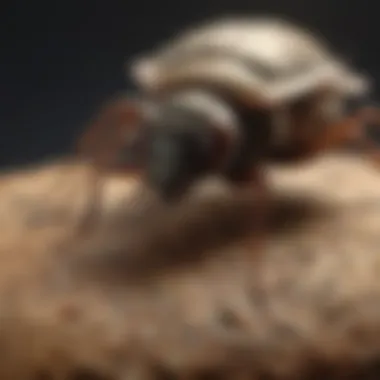

Surface treatment involves applying a borax solution to the areas surrounding the foundation and in areas where termites are likely to enter, creating a protective barrier. This method is advantageous in preventing future infestations.
Key Characteristic: It provides a preventative measure rather than merely reactively eliminating existing termites.
Unique Feature: Surface treatment can serve as a long-term strategy, particularly in previously infested areas.
The downside is that it requires thorough coverage, making it labor-intensive and possibly needing repeat applications to maintain effectiveness.
Proper application of borax can make a significant difference in controlling termite populations effectively.
In summary, the practical applications of borax are diverse and can be tailored to the needs of individual homeowners. From preparing solutions to using various application methods, borax proves to be a beneficial tool in managing termite infestations.
Safety Considerations When Using Borax
When utilizing borax for termite control, safety is a critical aspect that cannot be overlooked. Understanding the potential risks and appropriate handling measures safeguards both human inhabitants and pets. This knowledge ensures effectiveness in applying borax, alongside maintaining a safe living environment. The safety considerations encompass not just the chemical properties of borax, but also how to work with it responsibly.
Potential Risks to Humans and Pets
While borax is considered a less toxic alternative to some chemical insecticides, it is essential to recognize that risks exist. Here are some points to consider:
- Ingestion Hazards: Borax can be harmful if ingested in significant amounts. It may lead to nausea, vomiting, and abdominal pain. Therefore, it is crucial to keep borax out of reach of children and pets.
- Skin and Eye Irritation: Direct contact with borax can cause mild irritation to the skin and eyes. Such irritation may necessitate the use of gloves and eyewear for proper protection.
- Respiratory Concerns: Although not classified as highly toxic, inhaling borax dust can provoke respiratory discomfort. This effect emphasizes the need for a mask or proper ventilation during handling.
Handling Guidelines and Precautions
Safe handling of borax involves several best practices that prepare one for a secure application process. Consider the following recommendations:
- Personal Protective Equipment (PPE): Utilize gloves and protective eyewear when mixing or applying borax solutions. This step minimizes the risk of skin and eye contact.
- Application Areas: When applying borax, ensure areas are well-ventilated. Avoid enclosed spaces that could heighten inhalation risks.
- Storage Considerations: Store borax in a cool, dry place, securely away from children and pets. An airtight container is preferable to prevent unintended access.
- Disposal Protocols: Dispose of any unused or expired borax responsibly. Follow local regulations regarding hazardous materials to minimize environmental impact.
In summary, safety in using borax for termite management is paramount. By being informed and adhering to these handling guidelines, homeowners can mitigate risks while effectively tackling termite infestations. The careful application of borax ensures both safety and efficacy in pest management.
Environmental Impact of Borax Use
The environmental implications of using borax for termite control are important to consider. Homeowners and pest management professionals increasingly seek sustainable and eco-friendly pest control methods. Understanding how borax interacts with the environment can help ensure safe usage while minimizing adverse effects.
Borax and Soil Health
Borax is a naturally occurring mineral and its application can influence soil health positively. When introduced into the soil, borax can help with nutrient balance, particularly for certain crops that require boron in moderate amounts. This can enhance soil fertility over time. However, it is vital to apply it carefully. Too much borax can lead to soil toxicity which affects plant growth adversely. This demonstrates the need for precise usage based on specific soil conditions.
- Borax may enhance nutrient availability.
- Improper dosing can yield toxic results for plants.
- Regular soil testing can help manage borax levels effectively.
By maintaining proper borax application guidelines, homeowners can contribute to soil health while protecting their gardens and lawns. Thus, effective communication about its use is essential in assuring environmental safety.
Comparison with Chemical Termiticides
When comparing borax to traditional chemical termiticides, several factors come into play. Chemical termiticides often pose greater risks to non-target organisms and ecosystems. Their residues might linger, leading to potential contamination of soil and water sources. In contrast, borax, when used responsibly, presents a more controlled and less harmful option.
- Safety: Borax is less toxic to humans and pets compared to many chemical alternatives.
- Ecological Impact: While chemical termiticides disrupt ecosystems, borax tends to integrate without causing severe ecological damage.
- Sustainability: Borax is viewed as a more sustainable choice, promoting a healthier environment over time.
"The use of borax contributes to an environmentally responsible approach, minimizing risks that are often associated with conventional chemical pest control products."
In summary, while borax may not eliminate termites as rapidly as some chemical solutions, its lower environmental impact allows for a more thoughtful approach to pest management. Understanding this balance is key for homeowners dedicated to effective and sustainable termite control.
Integrated Pest Management Strategies
Integrated Pest Management (IPM) is a holistic approach to pest management that combines multiple strategies to control pest populations, in this case, termites. Understanding this approach is important for effective termite management, especially when considering the use of borax. IPM focuses on long-term prevention, rather than relying solely on chemicals. This method allows homeowners to reduce the risks associated with pests while protecting the environment.
Benefits of Integrated Pest Management
IPM presents several advantages:
- Sustainability: By integrating various methods, IPM promotes a sustainable approach that minimizes reliance on chemical pesticides, which can be harmful to the ecosystem.
- Cost-effectiveness: Utilizing a combination of strategies may lower long-term costs by preventing extensive damage to your property.
- Enhanced effectiveness: Combining borax with other methods increases the likelihood of success in controlling termite infestations.
Considerations in Integrated Pest Management
When employing IPM, several factors should be considered:
- Assessment of the Infestation: Understanding the level and type of termite infestation is crucial. This assessment will guide the choice of methods used.
- Best Practices: Implementing maintenance routines, such as regular inspections and repairs, can help reduce the chance of future infestations.
- Compatibility: It is essential to ensure that borax is compatible with other methods to be employed, avoiding any potential ineffectiveness.
"An effective integrated pest management strategy requires continuous monitoring and adjustment based on observed results."
By employing an IPM strategy that includes borax, homeowners can benefit from a more comprehensive approach to termite management. Understanding how to effectively combine borax with other methods in your pest management strategy can lead to substantial improvements in both efficacy and sustainability.
Combining Borax with Other Methods


To optimize the effects of borax in controlling termite populations, it is beneficial to combine its use with other pest management strategies.
- Physical Barriers: Establishing physical barriers, like steel mesh or fine wire, can prevent termites from entering the structure. Applying borax adjacent to these barriers helps reinforce your defenses.
- Biological Control Agents: Introducing natural predators of termites, such as certain fungi, can create a more hostile environment for them. Borax can be part of a baiting system that works alongside these biological agents to enhance effectiveness.
- Cultural Practices: Changing habits that favor termite infestations can be effective. This includes proper landscape management, like removing wood debris and maintaining a dry environment.
By integrating borax with these additional methods, you can create a multi-faceted approach that effectively reduces termite numbers. Each method complements the others, leading to a more efficient pest management strategy.
Monitoring and Evaluation of Treatment
Monitoring and evaluating the effectiveness of treatments is essential in the context of IPM.
- Regular Inspections: After implementing borax and other strategies, homeowners should conduct periodic inspections of their property. Look for signs of termite activity, such as mud tubes or damaged wood.
- Assessment of Treatment Success: Keep a record of observations post-treatment. Evaluate whether there are changes in termite activity or damage. This data is vital for understanding your strategy’s effectiveness.
- Adjustments as Necessary: Adapt your approach based on findings. If borax is not yielding the expected results, consider modifying the concentration or method of application or integrating new techniques.
Challenges in Using Borax for Termite Control
When considering borax as a method for termite control, it is crucial to acknowledge the challenges that can arise from its usage. While borax is often seen as a safer alternative to traditional chemical treatments, it does have limitations that homeowners must understand fully. This section aims to address these challenges, focusing on two critical issues: resistance development in termites and inherent limitations in the efficacy of borax as an insecticide.
Resistance Development in Termites
One significant challenge is the potential for resistance to develop within termite populations. Over time, insects can adapt to various substances used against them. Insects, including termites, can undergo genetic changes that allow them to withstand the effects of pesticides or other control methods.
When borax is used repetitively or improperly, there is a risk that termites may become increasingly resistant to it. A small portion of termites that survive a borax treatment can reproduce, and eventually, their offspring might inherit resistance traits. Therefore, relying solely on borax without integrating other control measures can lead to a situation where the substance becomes ineffective. This situation underscores the importance of using borax as part of a more extensive pest management strategy, rather than as the only solution.
Limitations in Efficacy
Borax does have limitations in its overall effectiveness, which must be considered in its application. One major limitation is that it is not an immediate killer. When termites ingest borax, it affects their digestive systems, but the fatal impact is not instant. Therefore, observing immediate results in termite populations can lead to dissatisfaction for those looking for quick eradication solutions.
Additionally, borax needs to be effectively placed in areas where termites are actively foraging. This requirement can prove challenging for homeowners who may not have the experience to locate active infestations. If borax is applied incorrectly or in the wrong locations, its efficacy will diminish significantly.
Furthermore, environmental factors such as moisture and the presence of competing food sources can dilute borax's effectiveness. Termites tend to prefer certain food sources over others; if alternative food is more appealing, the likelihood of them consuming borax may decrease.
"Understanding the challenges of using borax is crucial for effective pest management and ensuring long-term success in controlling termite populations."
In summary, while borax can be a part of a termite management strategy, recognizing and addressing resistance development and the limitations in efficacy is necessary. Effective pest control should always involve multiple strategies and ongoing monitoring to adapt as needed.
Case Studies: Borax in Action
Understanding practical applications of borax in termite management is essential. This section sheds light on real-world applications and outcomes. Case studies offer evidence of efficacy, showcasing how homeowners and professionals leverage borax due to its advantages as a pest control agent. These insights hold significance for effective pest management strategies. They do more than illustrate success; they provide lessons about best practices and potential pitfalls in using borax.
Successful Homeowner Experiences
Many homeowners have shared their positive experiencse with borax in termite management. A common scenario involves treating furniture or wooden structures. They often mix borax with water, creating a solution that is easy to apply. Some homeowners reported initial skepticism. However, after persistent application, they witnessed a notable decrease in termite activity.
Several key benefits emerge from these experiences:
- Cost-effectiveness: Many homeowners noted that using borax was significantly cheaper than hiring pest control services.
- Chemical safety: They appreciated that borax is less harmful to humans and pets compared to traditional pesticides.
- Simplicity: The ease of application allowed homeowners to engage directly in pest management.
Homeowner accounts reflect an increased confidence in utilizing environmentally friendly solutions. Their stories underline how borax application can lead to successful outcomes when conducted systematically.
Professional Application Outcomes
Pest control professionals have also employed borax with successful results. In controlled settings, they utilized borax as a primary ingredient in baiting systems. The meticulous research-backed application ensures that insects consume sufficient amounts. In many cases, professionals reported more effective outcomes compared to conventional chemical treatments.
Some significant points from these professional experiences include:
- Enhanced targeting: Professionals can strategically position borax in areas frequented by termites, maximizing exposure.
- Sustainable practices: Many pest control companies are leaning towards eco-friendly solutions, increasing the prevalence of borax.
- Noteworthy results: Case studies from certified pest management companies show substantial reductions in termite populations post-application.
"In our experience, opting for borax has shown promising results that align with sustainable pest management principles," commented a professional pest controller.
Professional case studies reinforce the value of borax as an effective solution against termite infestations. They provide a framework that homeowners can learn from to enhance their approaches in termite management.
Future Trends in Termite Management
The management of termite infestations is evolving. It's crucial for homeowners and pest control professionals to stay informed about future trends. These trends focus on developing more sustainable and effective solutions. Understanding these advancements can aid in better decision-making and more effective pest management strategies.
Emerging Solutions and Innovations
Innovative approaches are emerging in termite management. One of the prominent solutions involves the use of biological controls. This includes introducing natural predators that can effectively reduce termite populations. Another avenue is the enhancement of pheromone traps. These traps aim to confuse and disrupt the communication among termites, leading to colony breakdown.
In addition, advancements in technology are paving the way for smarter monitoring systems. Remote sensors can now detect termite activity in real-time. Such systems provide timely data, allowing homeowners to act quickly, reducing damage significantly.
Furthermore, researchers are exploring nano-technology applications in pest management. This method ensures targeted delivery of treatments, minimizing environmental impact. Emerging methods such as these highlight an ongoing shift towards safer, more efficient pest control solutions.
The Role of Research in Advancements
Research plays a vital role in advancing termite management practices. Ongoing studies provide insights into termite behavior and their ecological roles. Understanding these aspects helps in developing new, targeted solutions that can effectively disrupt their life cycles.
The collaboration between researchers and pest control industry professionals is essential. This partnership fosters the creation of evidence-based strategies. For instance, recent studies have shown the efficacy of integrating borax with biological controls. This combination maximizes impact and minimizes risks associated with chemical treatments.
Moreover, continuous research addresses the challenges of resistance development in termites. By understanding how termites adapt, new approaches can be designed to prevent and mitigate this issue. As a result, the research community's contributions are invaluable for creating long-lasting solutions to termite infestations.
By embracing these future trends, homeowners will empower themselves against termite infestations, leading to sustainable pest management solutions.



